Turning Software Inside Out
As our familiarity with software deepens, the question of its cultural understanding looms. Here Tony Sampson reviews FLOSS+Art and Software Studies: A Lexicon, two recent books which attempt to open up the black box to a wider audience
Having been asked to review these two books together forced the issue somewhat, but it would be difficult to review FLOSS+Art and Software Studies: A Lexicon in isolation. There are, as Ted Nelson put it, many ‘interwinglings'. Authors, academic institutions and shared lines of thought travel between both edited collections. Figuring out the significance of these manifold relations is perhaps as interesting a way as any other to tap into their joint subject matter: software. Indeed, both collections develop upon an important strand of the new media field with implications for understanding software as well as the working practices of authors, coders, designers, educators, artists, users, consumers, and activists. Above all, both books think through software not only in terms of what it does but what it is all about. To put it another way, FLOSS+Art and Software Studies aim to introduce software's inside to its outside.
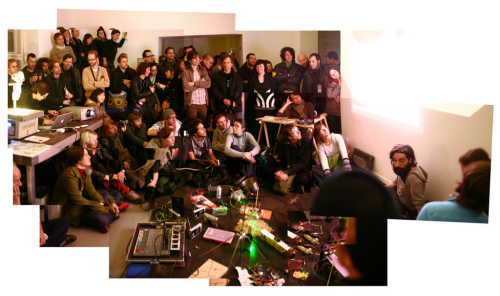
Image: xxxxx, Temporary Structure, Club Transmediale, 2009
Aware of the risk of oversimplifying how each book approaches the outside of software, I nevertheless wish to discuss them both according to two rudimentary questions. The first question asks how the discussion on code can go beyond the rhetoric of freedom so often associated with the open source movement. As Galloway and Thacker argue, the distinction between ‘open' (public, freedom and political transparency) and ‘closed' (private, proprietary and state regulated) simply ignores the issue that openness has its own ‘controlling logic'.i Relatedly, the second question asks, how can the study of software connect to its outside without being overwhelmed by an inside largely determined by (a) engineers who think only in terms of how to code, and (b) the corporate arena of profit. Similarly, FLOSS+Art asks how (Free/Libre/Open Source) software producers (predominantly collectives of artists) can wriggle out from under the corporate hold on digital culture. I am interested in how this welcome breach of the ‘how to' mindset of software engineering can also tackle the looping arguments that seem to beset discussions on freedom and restriction in open and closed computer systems. For the most part, FLOSS+Art follows Software Studies by managing to elide both the rhetoric and circularity of the openness debate. Certainly, the initiative behind Software Studies affords the reader a more distant position by which s/he can look back critically at the alterity of code. This is a scholarly contortionism that wraps itself around the creative potentialities and tragedies of interactive software in novel ways.
Opening Up Software
According to the blurb, FLOSS+Art aims to critically reflect on the growing relationship between free software ideology, open content and digital art. Its objective is to provide a view of the social, political and economic myths and realities linked to this phenomenon. Along these lines, editors Aymeric Mansoux and Marloes de Valk set out a familiar narrative in their preface in which the field of new media has come to understand the tragedy of interactive software. That is, where once most software was published online on an open and free to use basis, the corporate realisation that vast profits can be reaped from the seemingly boundless consumer passion for digital tools has functioned to close down the work (and play) environments of software creatives. Mansoux and de Valk remind us that the software industry no longer sells software: it sells licences. More than that, digital content consumption, once open to the free hack, is now increasingly limited to playback only mode. So, on the one hand, the new media producer is predetermined (from education to work) by the distribution and consumption of corporately defined creative tools. On the other hand, the user festers in the passivity of a range of ‘interactive' experiences evermore linked to indirect consumption opportunities. FLOSS+Art therefore sets out an alternative vision intended to return production and consumption of digital art back to the values of the free software and open source movements: the principles of free use, free access to source code, and freedom to share, customise and distribute software.
The editors of FLOSS+Art are fully aware of how the corporatisation of software has turned the digital creative into a consumer. Propriety operating systems (Mac and PC), alongside the nurturing of user passions for the latest Adobe version updates, ostensibly monopolise and organise education and workplace environments. As Michael van Schaik's contribution notes, most creatives seem not to care. Indeed, educators are often complicit in the production of obsessive Flash and Photoshop users. After the University, the Adobe tool-chain (as van Schaik calls it) stretches out to the ‘creative' job market where specific skill requirements in certain applications determine future careers. FLOSS+Art is, in this context, a valid attempt to think through an escape route out of the confines of the Adobe Creative Penal Suite.
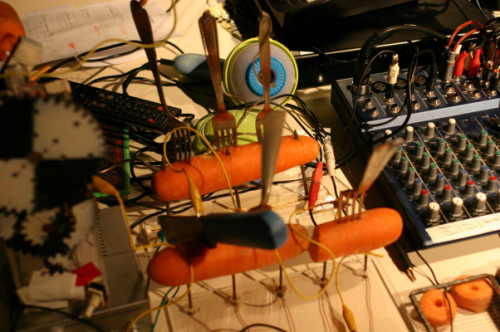
Image: xxxxx, Temporary Structure, Club Transmediale, 2009
But what exactly does FLOSS offer as an alternative? Well not free beer exactly. Instead of buying a glossy box and access to Adobe's helpline, FLOSS software comes packaged with a community of users and producers. The FLOSS creative is not therefore a slave to Adobe, but part of an open social network that enhances the freedom to create. This is an interesting proposition put forward by the editors, but referring back to the first question posed above, how does FLOSS distance itself from the rhetoric of freedom? Well, Julien Ottavi's article, ‘The Free and New Creative Practices', argues that the open movement is confronting the concepts of property. He rallies behind the governance of new open source and free software licencing. For him, ‘[t]he "free" unlocks the doors of fear and ignorance, of one-way economics'. The software author is ‘liberated', enabled to share code and freely modify it. But beyond this admirable reverie, there surely needs to be a degree of cynicism expressed over the extent to which there has been a historical turn towards free collective authorship. Indeed, despite the promises of freedom in open collaborative networks, the ‘fictional' conversations between Femke Snelting et al expose artists still apparently clinging to notions of authority. Copyleft licences, we are told, like the Creative Commons, provide an ‘interesting alternative to the traditional copyright system, but the individual author still remains the starting point'. One proposed alternative to the macro-economy of the blockbuster killer application is, it seems, a micro-economy of open file sharing and longtail niche programs. But isn't this ‘new' economy already colonised by the corporate arena? The empty spaces in between the rhetoric require further scrutiny. What does openness really add up to in political terms? In his recent book, Nigel Thrift attempts to answer this question by pointing to the open source movement's uncomfortable association with the corporate trend to ‘free reveal'. The ‘democratising of innovation' is part of a strategy to tap into the ‘enthusiasms and pleasures of consumers'.ii There is not, arguably, a simple opposition between the open source movement and the closed supply chains of the corporation. The alliances between software production and social power are endemic of late capitalism's drive to extract profit from anything that moves on the network.iii
FLOSS+Art does not, however, persist with the rhetoric. There is much probing of what openness is all about. In no particular order, Pedro Soler, for example, points out that great works of art have never been produced in isolation. Despite the focus on the end product of the creative genius, he argues that great art develops through social movements. He sees a continuum here between the socialities of art movements and the open and collaborative networking of digital art, and its potential to stimulate new movements. He rightly notes that the problems facing these novel movements - mainly funding and the intellectual appropriation of programming skills - are yet to be solved, though. Similarly, the artist Simon Yuill interrogates the entire notion that collaboration is a form of resistance. He offers an alternative perspective on the corporate ‘harvesting' of collaborative practices as a mode of organising the digital economy. The contribution of the already mentioned van Schaik engages further with Adobe's grip on education. He argues that the tragedy of interactive software could be addressed by introducing clone packages like Scribus and Gimp as alternatives to Photoshop and Illustrator. But to what extent has Adobe already become the medium of ‘choice'? Can these software clones really break the Adobe supply chains that link education and workplace institutions together?
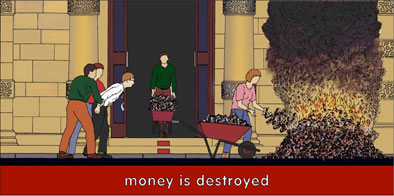
Image: Chad McCail, Money is Destroyed, 2009. Part of the drawing series forming the basis of Simon Yuill's Spring Alpha, a networked game system
Inevitably, the utopia of openness is disrupted by the concrete and contested realities of copyright law. This is, not surprisingly, a major theme that keeps cropping up in FLOSS+Art. After all, digital creatives are authors - in collaboration or isolation. The struggle for control over ownership rights with publishers and copyright owners is part of their world. It is interesting, then, that Han Christoph Steiner concludes his article by suggesting that in an ‘ideal world' the disintermediation processes of new media would do away with the need for copyright law and publishers altogether, with all this brought about, apparently, by the erosive forces of free culture. Again, the looping logic of the open/closed argument makes a slight return, before Florian Cramer, in his contribution, ‘The Creative Common Misunderstanding', soberly points out that the negotiations over the Creative Commons Licence, intended to lessen the grip of the corporation, have nonetheless functioned to reserve the rights of the corporate copyright owner over artists and their audiences. Digitality proves to be a less than ideal world in which debates about copyright law are mostly framed from the perspective of ownership.
Many of the contributions in FLOSS+Art tend to open more than the shrink-wrapped boxes in which we consume software. They open up to a new space of thought. 0Rx-qX, for example, responds critically to what is ‘free' by recognising that this new space will not be made by the self-organisational properties of the network per se. Democracy is not a given in collaborative network environments. As 0Rx-qX argues, file sharing provides anonymity for both pirates and the corporate spies from the Recording Industry Association of America (RIAA). Moreover, freedom networks do not simply grow on code alone, but require people to develop them. The social media model of Web 2.0 clearly demonstrates how the ‘people first' dynamic has become a function of corporate-determined software markets. It also shows how the people can wittingly and unwittingly get sucked into what 0Rx-qX calls the ‘elaborate addiction pyramids of corporations'. It is useful then that Olga Goriunova pursues the whole notion of what is ‘free' with regard to immaterial labour on a network. Her piece includes, as such, a helpful reference to Tiziana Terranova's (apparently rare) work on how ‘freeness' features in advancing developed forms of capitalist production in network culture. Beware the utopia of open autonomy.
What I got from reading the contributions to FLOSS+Art is a sense that the new space of software is one that needs to be continually reclaimed, over and over again. As Sher Doruff concludes (following Guattari), software is not just open, but is becoming open and consequently attaching itself to novel assemblages. That is what makes the inside of software free: its capacity to affect and be affected by an outside.
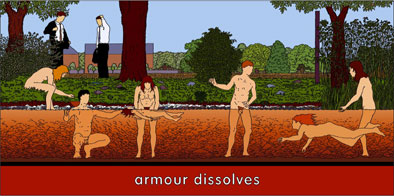
Image: Chad McCail, Armour Dissolves, 2009
Software Has An Outside
In Software Studies, the link to the open source and free software sentiment of FLOSS+Art is a faint but noticeable trace. A few of the FLOSS contributors passed through The Piet Zwart Institute as research fellows, teachers or students when Matthew Fuller (the editor of Software Studies) was a reader there, perhaps providing an institutional location for the early development of ideas around software. However, unlike the more rhetorical moments of FLOSS+Art, the forté of Fuller's Software Studies is that it manages to break out of the loop of the open/closed debate. This enables the contributors to attach software to manifold lines of critical thought. There is, like FLOSS+Art, a heavy emphasis placed on collaborative work. Yet this is not solely centered on code production, but between collaborative modes of thought. It is entirely fitting that an edited collection, full of bite size critical explications by different authors on software, should accompany what Fuller describes as ‘a field that is collectively opened up'. Certainly, what would appear to be the obvious centrepiece of the book is interestingly hidden away on page 40-something rather than stacked atop a hierarchy of authorial importance. This might be an advantage since what this first translation of Kittler's article ‘Code (or, How You Can Write Something Differently)' argues is nothing short of code determinism. Kittler explicitly states that what determines us today is code. Not just computing or genetic algorithms, but code inventions historically stretching across Roman alphabets to Turing machines. One of the accusations that might confront Software Studies as a result is that it is a reduction of everything to code. Nevertheless, go back a few pages from Kittler, and although Andrew Goffey locates the algorithm as central to the field, his analysis, like many other efforts in this collection, tries to think about code by thinking through code. In this first instance, the inside of code is forced to countenance Foucault's statements and the transversalisms of Deleuzian machinic discourse. The effect is to slow down the algorithmic influence on everything it affects.
The focus in much of Software Studies shifts from the concerns of openness and closure expressed in FLOSS+Art to the viral capture of contemporary creative media practices. A number of notable contributions observe the transductive capacities of software to hijack media formats and reinvent them. Like this, Adrian Mackenzie takes an altogether different perspective to digital video than that expressed by Ross Harley in FLOSS+Art. Rather than seeing broadband as the ‘new hope' for the video author, Mackenzie observes the monstrous algorithmic complexities of file compression and decompression which have restructured contemporary media cultures and economies. He asks what becomes of video after Mpeg? Similarly, Jussi Parikka asks what happens to the aesthetic after the copying function has captured it, and Graham Harwood asks what becomes of the image after the network. In place of the binary oppositions of the open/closed loop, the reader begins to get a feel for the role of software in media ecologies. As Fuller recently argued at the Media, Communications, and Cultural Studies Association (MeCCSA) conference at The National Media Museum in Bradford earlier this year, ‘if you can't analyse software, how do you make an account of the contemporary music industry, music production or aesthetics? Otherwise you fall simply into accounts of bad people doing bad things: pirates or businessmen.'
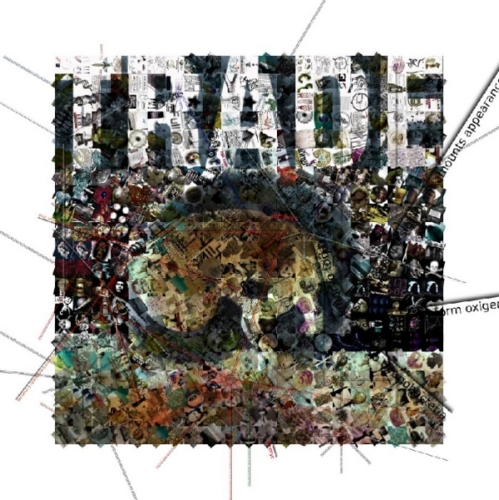
Image: Francesca da Rimini/Mongrel, from the ROUGH TRADE series, a NetMonster project, 2005
Nevertheless, bad things do happen. Ron Eglash's article returns, as such, to the themes of FLOSS+Art, drawing attention to new opportunities to reconfigure the alliances between computing power and social power. Again, the potential of software to disintermediate in favour of small businesses is recognised. If only it could be used to pull in low income areas into wide scale production instead of pandering to the usual elites of the programming community. Similarly, Harwood's code poem, which might need a bit of debugging to get it to run on Linux, makes a spirited point about class and code, and a few bad people to boot.
In order to mitigate, to some extent, the hegemony of digital invention that so noticeably saturates Software Studies, Derek Robinson presents an interrogation of the term analogue - lest we forget that software was not born in the digital age. Simon Yuill returns, intensely hacking into Proudhon and Foucault to identify the anarchic processes that underlie the seemingly well ordered world of collaborative software production. What is becoming open is no homeostasis. We also get an insight into the seemingly irrational side of logic. Olga Goriunova features again with Alexei Shulgin to extol the new aesthetic of the glitch: a transformational manifestation of software culture in human-computer assemblages that would otherwise be technically described as dysfunctional. It is the anomalies of software in social, cultural, political, economic and aesthetic stratospheres, not just ‘normative' logics, that matters here. Even the current dysfunctionalities in the global economy are intimately coupled to the algorithm. As Fuller interestingly pointed out in Bradford, 40 percent of the trading decisions in the recent financial crash were automated, through so called algorithmic trading, while the rest were sped up by ICTs.iv
One problem that might face the student of software studies is how to make writing about software concern the stuff of software without adding to the glut of technical description of objects found in engineering literature. As a template, Søren Pold's article usefully highlights the social engineering of software by focusing on the buttons of interface design. This might be of interest to educators teaching software who become numb to the reams of technical description students are asked to rehearse. Other chapters on lists (Alison Adam) and loops (Wilfred Hou-Je Bek) interestingly criss-cross the two cultures. Lists are linked to the historical ordering of things (Foucault again) and loops aligned to Coleridge. The chapter on variables (Derek Robinson again), however, seems to slide back into the descriptive zone. Variables are ‘like empty boxes' - a similar description I recall reading from a programming manual. My point is that while this new field admirably aims to refresh a part of the cultural and media field that has otherwise ignored how software has transformed the mediascape, it works best when it carefully composes software and culture rather than uncritically regurgitating the user manual. This is clearly a difficult trick, but as Fuller pointed out in Bradford, the intention of the field is to ‘allow distinctly cultural values to enter into composition with technical ones.'
Unlike the sweeping generalisations made about software in much of media studies, Fuller's book opens up a space for discussion that is able to reshape the problem without losing the specificity of technical knowledge. Likewise, when the cultural analysis of software gets caught up in representational tendencies and a semiotic obsession with the interface, it misses the real meat of the subject matter which resides in the performative modes of passwords, pin numbers, bleeps, alerts and the glitches of digitality. Software Studies reminds me, at least, that function can be beautiful too. Indeed, it becomes engaged in a critical analysis of code that probes the whole idea of software as culture. As Fuller put it in Bradford, ‘we [software studies, that is] recognise the rich internal culture of programming which uses many means, including code itself, as a way of talking about code.' From what I can ascertain, software studies is not simply about replacing how to code with talk about code. Instead, as Fuller put it more articulately, it concerns ‘talking through code'. Software Studies and FLOSS+Art (loops aside) manage to accomplish this. I therefore recommend both as key readers for those new media students, educators and practitioners who would like to see software turned inside out.
Tony D. Sampson <T.D.Sampson AT uel.ac.uk> is an academic and writer [http://homepages.uel.ac.uk/T.D.Sampson/]. He lectures on new media and network culture at the University of East London where he also leads the multimedia and interactive media degree programmes. Tony is the co-editor of The Spam Book: On Viruses, Porn, and Other Anomalies from the "Dark Side" of Digital Culture forthcoming from Hampton Press in the US. His book Virality: Contagion Theory in the Age of Networks is also due out soon.
Info
FLOSS+Art, edited and compiled by Aymeric Mansoux and Marloes de Valk. London: Openmute, 2008
Software Studies: A Lexicon, edited by Matthew Fuller, MIT Press, 2008
Footnotes
i See Galloway and Thacker The Exploit: A Theory Of Networks, Minnesota, 2007, pp.124-126.
ii See chapter one of Thrift's book Non-Representational Theory, Routledge, 2008, p.41. Elsewhere, the political flaws in open source movements have come under further scrutiny. In The Exploit: A Theory Of Networks, Galloway and Thacker argue that the movement fetishises ‘code in isolation' and thereby offers few clues to the alliances between software production and social power beyond saying that code can be ‘open' and ‘free'.
iii These are not small trickles of profit either, but billion dollar income revenues generated by corporations like Hewlett-Packard from open source related products. See ‘HP Records More Than $2.5 billion in Linux-Based Revenue in 2003', http://www.hoise.com/primeur/04/articles/monthly/AE-PR-02-04-31.html
iv See also Sean Dodson, Was Software Responsible for the Financial Crisis? The Guardian, Thursday 16th October 2008,http://www.guardian.co.uk/technology/2008/oct/16/computing-software-financial-crisis
Mute Books Orders
For Mute Books distribution contact Anagram Books
contact@anagrambooks.com
For online purchases visit anagrambooks.com






